For more than two decades, artist Paula Bannan has worked with clients, from elite athletes to celebrities, homeless teenagers to captains of industry, using art therapy to help them process a variety of mental health and emotional issues.
Bannan’s art therapy is one of a host of experiential therapies offered at Raindrum, a specialist provider of private rehabilitation, preventative and performance health and wellbeing residential programs which combine clinical, allied health and experiential treatments.
A calming, positive experience
Bannan’s art sessions aren’t Freudian explorations, where every squiggle is analysed and interpreted.
“I never broach a client’s emotional challenges,” she says. “I come from an arts background, not a psychology background.
“I never expect anyone to tell me their problems.
"What I try to achieve, working with people in rehabilitation, is that they find painting enjoyable. My style of therapy is meant, primarily, to relax the client.
“I just want them to learn something that allows them to have a positive experience.”

Right brain activity
Many clients are surprised at how powerful the process of painting is. The creation of art not only unlocks emotions but, the process itself comes with a sense of peace.
Bannan says there’s a meditative quality to painting that allows anxieties to be switched off.
Art stimulates right brain activity, where our creativity happens, and this releases the feel-good hormones dopamine and serotonin.
“That’s why sitting, painting, makes you feel really calm,”
she says.
“Some high-profile businesspeople have said to me, ‘why should I paint a picture?’”
The answer, says the artist, is that these people may be the best in the world at what they do, but they are left-brain orientated; tapping into a different part of their intelligence helps them tap into the emotional places required for healing and rehabilitation.
Bannan says that while addictive behaviour, whether that is workaholism, or dependence on drugs and alcohol, narrows a person’s options, creative arts expands them.
Whether clients learn to play a musical instrument, write, or paint, through creativity they are able to slowly move to a place where they can heal, increasing their ability to tolerate and understand a greater range of feelings.
See yourself in another light
Another benefit of art therapy is that it can expand a client’s view of themselves, says Bannan.
Yes, there can be a leap of faith required.
No matter how extraordinary their achievements in the world, many clients judge themselves harshly when it comes to artistic ability.
However, Bannan says the idea that there are good and bad artists is nonsense.
“Everyone is an artist, and I’ve never had a client who wasn’t able to produce a piece of artwork in one form or another,”
she says.
Make a mess and start again
Bannan uses the free painting technique to start her session, which she says is non-threatening for clients.
“All of my sessions begin with me ‘destroying’ that big scary white canvas.
“We mess it up, so we can paint over it and start again.
“It’s a great way to loosen up and explore creativity without fear.
”Clients choose colours that appeal to them, and work with whatever comes into their subconscious brain."
No matter the starting point, Bannan tailors all her sessions to suit each person, from beginner to more technically proficient, to build a sense of mastery.
While one art therapy class will deliver any number of benefits, clients may also choose to continue with painting sessions and, going forward, to incorporate this relaxing and healing therapy into their lives.
Evidence supports effectiveness
Backing up her own experience in working with clients to achieve mental health results, a systematic review of the clinical effectiveness of art therapy found significantly positive effects on depression, anxiety, low mood, trauma, distress, inability to cope and low self-esteem.
Another study found that, through relatively short-term interventions in art therapy, it has been possible to significantly improve the emotional state and perceived symptoms of some cancer patients.
A review of art therapy and Post Traumatic Stress Disorder found that war veterans who took part in 12 to 14 art therapy sessions also saw significant improvement in trauma symptoms, emotional state and quality of life.
Finally, art therapy was found to have helped healthcare professionals reduce levels of stress, anxiety, and burnout connected to their work.



